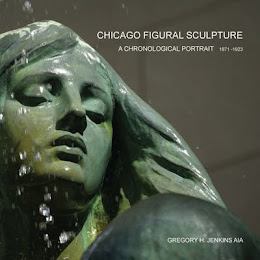.
DANIEL CHESTER FRENCH
With a sculptor so closely associated with Chicago, as certainly is Daniel Chester
French, it is possible to believe that he belongs to us.
THE GRAND BASIN. WORLD'S COLUMBIAN EXPOSITION 1893
His statue "The Republic" overlooked the Grand Basin
(and the Manufacturer's Building ) at the World's Columbian Exhibition in 1893
and its golden replica (now a Chicago Landmark) dominates East Hayes Drive in Jackson Park. The original was second in size only to New York's Statue of
Liberty. (And here I'll have to admit
that I can't imagine Daniel Burnham building the "second biggest"
anything -- especially with New York as the competition.) But still, almost as big WAS still big.
I stumbled onto
French's allegorical works "Manhattan"
and "Brooklyn," while researching
the "1917 American Architect." Daniel
Chester French's sculpture is national in scope. With a substantial amount of work in New York.
I shouldn't have been surprised.
.
"BROOKLYN" at the Manhattan Bridge
.
"MANHATTAN" at the Manhattan Bridge. (Is that a peacock I see?)
Chicago
has a history of bringing home the best.
And making it our own.
+++
THE HALL OF LIBERAL ARTS AND MANUFACTURERS
Gustave Eiffel is most famously credited with the internal
structure of the Statue of Liberty. But
it was Norwegian born structural engineer Joachim Giaver, who, while chief
engineer for the Schiffler Bridge Company of Pittsburgh, designed the internal framework.
Giaver went on to become William Shankland's assistant at the Columbian
Exposition, where he is credited with the design of the largest three hinge
arch in the world -- at the Manufacturers and Liberal Arts
Building. Daniel Burnham didn't waste
any time after the fair. He hired Giaver at D.H. Burnham & Company -- where
he engineered innovative foundations and structural steel frames for Burnham's
classic skyscrapers for seventeen years (before setting up independent shop
with Burnham designer Frederick Dinkelberg.)
+++
A reputation earned at the Columbian Exposition could support a lifelong career. Carl Beil, Superintendent of Sculpture at the Chicago Fair formed a long and successful partnership with Leon Hermant (French Sculptor at the Saint Louis Fair). To see their work in Chicago, link <
HERE>
+++
I would really like a photograph of Carl Beil!

























































































